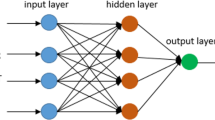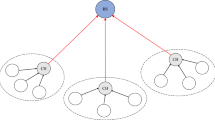Abstract
In multi-hop ad hoc networks, besides collision-free transmissions, channel utilization should be also enhanced due to the scarce bandwidth. In this paper, we propose a learning automat-based adaptive polling scheme for medium access scheduling in clustered wireless ad-hoc networks to enhance the channel utilization. In this scheme, each cluster-head takes the responsibility of coordinating intra-cluster transmissions so that no collisions occur. Taking advantage of learning automaton, each cluster-head learns the traffic parameters of its own cluster members. Cluster members are prioritized based on these traffic parameters. Each cluster-head then takes the traffic parameters into consideration for finding an optimal channel access scheduling within its cluster. By the proposed polling scheme, each cluster member is assigned a portion of bandwidth proportional to its need (i.e., traffic load). The results show that the proposed channel assignment policy considerably improves the channel utilization. Simulation experiments also show the superiority of the proposed polling-based medium access scheme over the existing methods in terms of channel utilization, waiting time for packet transmission, and control overhead.
Similar content being viewed by others
References
Callaway E.H. (2005) The wireless sensor network MAC. In: Stojmenović I. (Ed.) Handbook of sensor networks: Algorithms and architectures. New Jersey, Wiley-Intersciences
Saleh A. A. M. (1982) Inter-modulation analysis of FDMA satellite systems employing compensated and uncompensated TWTs. IEEE Transactions on Communications 30(5): 1233–1242
Lee W. C. Y. (1991) Overview of cellular CDMA. IEEE Transactions on Vehicular Technology 40(2): 291–302
Sekimoto T., Puente J. G. (1968) A satellite time-division multiple-access experiment. IEEE Transactions on Communications 16(4): 581–588
Capone, A., Gerla, M., & Kapoor, R. (2001). Efficient polling schemes for bluetooth picocells. In Proceeding of the IEEE international conference on communications (ICC2001), Vol. 7, pp. 1990–1994, Finland.
Chrapkowski, A., & Grube, G. (1991). Mobile trunked radio system design and simulation. In Proceedings of the IEEE vehicular technology conference (pp. 245–250).
Goodman D. J., Valenzuela R. A., Gayliard K. T., Ramamurthi B. (1989) Packet reservation multiple-access for local wireless communications. IEEE Transactions on Communications 37: 885–890
Abramson, N. (1970). The ALOHA system-another alternative for computer communications. In Proceedings of the AFIPS fall joint computer conference, Vol. 37, pp. 281–285.
Kleinrock L., Tobagi F. A. (1975) Packet switching in radio channels: Part I—carrier sense multiple-access modes and their throughput-delay characteristics. IEEE Transactions on Communications 23(12): 1400–1416
Grillo, D. (1990). Polling mechanism models in communication systems—some application examples. In H. Takagi (Ed.), Stochastic analysis of computer and communication systems (pp. 659–698).
Wang K., Peng M.-G., Wang W.-B. (2007) Distributed scheduling based on polling policy with maximal spatial reuse in multi-hop WMNs. The Journal of China Universities of Posts and Telecommunications 14: 22–27
Lye K., Seah K. (1992) Random polling scheme with priority. Electronics Letters 28: 1290–1291
Lagkas T. D., Papadimitriou G. I., Pomportsis A. S. (2006) QAP: A QoS supportive adaptive polling protocol for wireless LANs. Computer Communications 29: 618–633
Yang C. C., Liu C.-F. (2004) A bandwidth-based polling scheme for QoS support in bluetooth. Computer Communications 27: 1236–1247
Dimitriadis G., Pavlidou F. N. (2003) Two-hop polling: An access scheme for clustered, multihop ad hoc networks. International Journal of Wireless Information Networks 10(3): 149–158
Tseng, C. C., & Chen, K. C. (2002). Priority polling with reservation wireless access protocol for multimedia ad-hoc networks. In Proceedings of vehicular technology conference, Vol. 2, pp. 899–903.
Narendra K. S., Thathachar M. A. L. (1989) Learning automata: An introduction. Printice-Hall, New York
Thathachar M. A. L., Harita B. R. (1987) Learning automata with changing number of actions. IEEE Transactions on Systems, Man, and Cybernetics SMG17: 1095–1100
Billard E. A., Lakshmivarahan S. (1999) Learning in multi-level games with incomplete information-part I. IEEE Transactions on Systems, Man, and Cybernetics-Part B: Cybernetics 19: 329–339
Akbari Torkestani J., Meybodi M. R. (2010) A new vertex coloring algorithm based on variable action-set learning automata. Journal of Computing and Informatics 29(3): 447–466
Nicopolitidis P., Papadimitriou G. I., Pomportsis A. S. (2006) Exploiting locality of demand to improve the performance of wireless data broadcasting. IEEE Transactions on Vehicular Technology 55(4): 1347–1361
Xing Y., Mathur C. N., Haleem M. A., Chandramouli R., Subbalakshmi K. P. (2007) Dynamic spectrum access with QoS and interference temperature constraints. IEEE Transactions on Mobile Computing 6(4): 423–433
Meybodi, M. R. (1983). Learning automata and its application to priority assignment in a queuing system with unknown characteristics. Ph.D. thesis, Department of Electrical Engineering and Computer Science, University of Oklahoma, Norman, Oklahoma, USA.
Hashim A. A., Amir S., Mars P. (1986) Application of learning automata to data compression. In: Narendra K. S. (Ed.) Adaptive and learning systems. Plenum Press, New York, pp 229–234
Unsal C., Kachroo P., Bay J. S. (1999) Multiple stochastic learning automata for vehicle path control in an automated highway system. IEEE Transactions on Systems, Man, and Cybernetics-Part A 29: 120–128
Barto A. G., Anandan P. (1985) Pattern-recognizing stochastic learning automata. IEEE Transactions on Systems, Man, and Cybernetics SMC-15: 360–375
Nicopolitidis P., Papadimitiou G. I., Sarigiannidis P. G., Obaidat M. S., Pomportsis A. S. (2011) Adaptive wireless networks using learning automata. IEEE Wireless Communications Magazine 18(2): 75–81
Esnaashari M., Meybodi M. R. (2010) Dynamic point coverage problem in wireless sensor networks: A cellular learning automata approach. Journal of Ad hoc and Sensors Wireless Networks 10(2–3): 193–234
Esnaashari M., Meybodi M. R. (2010) Data aggregation in sensor networks using learning automata. Wireless Networks 16(3): 687–699
Akbari Torkestani J., Meybodi M. R. (2011) Weighted Steiner connected dominating set and its application to multicast routing in wireless MANETs. Wireless Personal Communications 60(2): 145–169
Akbari Torkestani J., Meybodi M. R. (2011) A mobility-based cluster formation algorithm for wireless mobile ad-hoc networks. Cluster Computing 14(4): 311–324
Haleem M. A., Chandramouli R. (2005) Adaptive downlink scheduling and rate selection: A cross-layer design. IEEE Journal On Selected Areas in Communications 23(6): 1287–1297
Xing Y., Chandramouli R. (2008) Stochastic learning solution for distributed discrete power control game in wireless data networks. IEEE/ACM Transactions on Networking 16(4): 932–944
Beigy H., Meybodi M. R. (2009) Cellular learning automata based dynamic channel assignment algorithms. International Journal of Computational Intelligence and Applications 8(3): 287–314
Nicopolitidis P., Papadimitriou G. I., Obaidat M. S., Pomportsis A. S. (2005) Carrier-sense-assisted adaptive learning MAC protocols for distributed wireless LANs. International Journal of Communication Systems 18(7): 657–669
Beigy H., Meybodi M. R. (2011) Learning automata based dynamic guard channel algorithms. Journal of Computers and Electrical Engineering 37(4): 601–613
Akbari Torkestani J., Meybodi M. R. (2010) An intelligent backbone formation algorithm for wireless ad hoc networks based on distributed learning automata. Computer Networks 54(5): 826–843
Misra S., Tiwari V., Obaidat M. S. (2009) LACAS: Learning automata-based congestion avoidance scheme for healthcare wireless sensor networks. IEEE Journal on Selected Areas in Communications 27(4): 466–479
Akbari Torkestani, J. (2012). LAAP: A learning automata-based adaptive polling scheme for clustered wireless ad-hoc networks. Wireless Personal Communication. doi:10.1007/s11277-012-0615-5.
Akbari Torkestani, J. (2012). An adaptive backbone formation algorithm for wireless sensor networks. Computer Communications (to appear).
Akbari Torkestani, J., & Meybodi, M. R. (2012). Finding minimum weight connected dominating set in stochastic graph based on learning automata. Information Sciences (to appear).
Akbari Torkestani, J. (2012). An adaptive learning automata-based ranking function discovery algorithm. Journal of Intelligent Information Systems. doi:10.1007/s10844-012-0197-4.
Akbari Torkestani, J. (2012). A stable virtual backbone for wireless MANETS. Telecommunication Systems Journal (to appear).
Akbari Torkestani, J. (2012). A new approach to the job schedulingc problem in computational grids. Journal of Cluster Computing (to appear).
Akbari Torkestani J. (2012) Degree constrained minimum spanning tree problem in stochastic graph. Journal of Cybernetics and Systems 43(1): 1–21
Akbari Torkestani J., Meybodi M.R. (2011) LLACA: An adaptive localized clustering algorithm for wireless ad hoc networks based onlearning automata. Journal of Computers & Electrical Engineering 37(4): 461–474
Author information
Authors and Affiliations
Corresponding author
Rights and permissions
About this article
Cite this article
Torkestani, J.A. LAAP: A Learning Automata-based Adaptive Polling Scheme for Clustered Wireless Ad-Hoc Networks. Wireless Pers Commun 69, 841–855 (2013). https://doi.org/10.1007/s11277-012-0615-5
Published:
Issue Date:
DOI: https://doi.org/10.1007/s11277-012-0615-5




